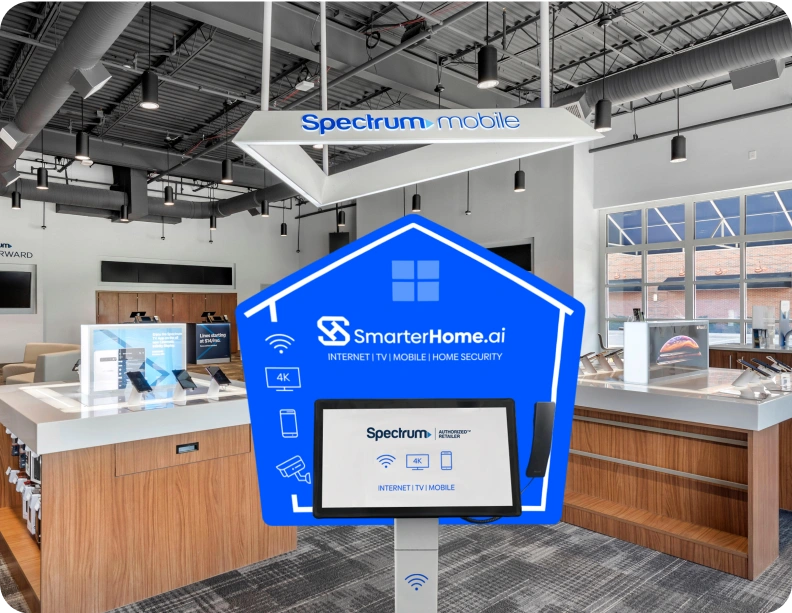Best Internet Providers in Harlingen, TX | SmarterHome.ai
Tired of Buffering? SmarterHome.ai is Your Golden Triangle Speed Upgrade in Harlingen, TX
Let’s make buffering a thing of the past – like payphones and dial-up. Whether you’re hopping on a video call, bingeing game day coverage, or endlessly scrolling TikTok while waiting at Valley Baptist, we help you lock in internet, TV, and mobile plans that actually work for your life.

SmarterHome.ai is your trusted provider of home services in Harlingen, TX.
Just visit SmarterHome.aiand punch in your address, and we’ll show you what’s real in Harlingen – from Palm Valley to the Arroyo, all the way down I-69E. Fiber internet? Check. Cable? Yup. 5G home internet? Oh yeah. We sort out the technical mumbo jumbo (like “deprioritization” and “hotspot limits”) so you know exactly what you’re getting – no surprises, no head-scratching.
Streaming by Hugh Ramsey Nature Park? Gaming near the Iwo Jima Monument? Zooming from your kitchen table? Wherever you are in Harlingen, SmarterHome.ai helps you compare local internet providers, pick a mobile plan that doesn’t throttle, and line up the perfect TV package. You can even bundle internet + TV + mobile for savings that actually stick. No tricks, no hidden fees – just real deals, clearly explained.

Starting from
$60/mo
500 Mbps
- No Contracts. Get your freedom.
- Fiber Plans include AT&T ActiveArmor 24/7 Network Security Protection.
- Speeds up to 5 Gigs with Select Plans.

Starting from
$30/mo
500 Mbps
- Contract Buyout Spectrum Internet® up to $500.
- No Contracts, Data Caps or Hidden Fees.
- Up to 1 Gig Internet Speed (wireless speeds may vary).

Starting from
$49.99/mo
500 Mbps
- No Contracts or Hidden Fees (Transparent pricing).
- Fiber Plans include a FREE Wi-Fi Router; Fiber 500+ comes with a FREE Amazon Eero Router.
- Speeds up to 5,000 Mbps (wireless speeds may vary).
Welcome to Harlingen: Chill Living, Serious Streaming
Harlingen is the kind of town where your weekend might include a trip to South Padre, a morning birdwatching walk, and tacos before sunset. It’s laid-back, sure – but your Wi-Fi better not be.
Between remote work, online classes, smart home gadgets, and late-night streaming, you need a connection that moves at your speed. That’s where we come in. SmarterHome.ai helps you compare internet services so your household stays connected, no matter how many devices are on the network (looking at you, smart fridge).
What Should I Look for in a Harlingen, TX Mobile Plan?
For every connected device, lag is the enemy. Whether you’re in Combes, Primera, or right in town, your home internet needs to be fast, reliable, and free of surprise slowdowns.
You can run an internet speed test right now to check your current setup’s download speed, upload rate, and Wi-Fi speed. (Just enter “test my speed” or “how fast is my internet” into a search bar and you’ll get plenty of results.)
What Should I Look for in a Harlingen Mobile Plan?
Your phone is basically your sidekick – whether you’re running errands down 77, flying out of HRL, or soaking up the sun in South Padre. So you want a mobile plan that won’t quit on you halfway through the month.
We’ll show you which carriers have solid coverage across Harlingen (and the routes you drive every day), how much high-speed data you’ll actually get, and whether your hotspot plan can power your laptop without giving up. Got travel plans? We’ll flag the plans with solid roaming perks so you’re not stuck paying extra when you cross the border or go off the grid.
And don’t worry – we explain things like deprioritization and video resolution limits like actual humans, not robots.
What Are the Best TV Providers in Harlingen?
TV shouldn’t be complicated. You want the Cowboys on Sunday, cartoons for the kids, some classic novelas, and maybe a reality show or three. We’ll help you pick a plan that gives you what you do want, and none of the 80 channels you’ve never watched.
Looking for regional sports networks? Cloud DVR that doesn’t erase your shows after a week? A 4K upgrade that actually works with your TV? We’ve got you. Prefer no contract? Or want the lowest price locked in? We compare that, too. Whatever your binge style is, we’ll help you set up a home TV provider that fits your lifestyle and budget.
How Do I Choose a Home Security System in Harlingen?
Smart security is more than just cameras – it’s peace of mind. Whether you’re in Treasure Hills or Sun Valley, we help youcompare home security options that work with your home layout, your phone, and your smart devices. Want pro monitoring? Need compatibility with Alexa or Google Home? We’ve got you.
And we’ll make it super clear which systems require contracts, how long they last, and what kind of support you get if something goes wrong.
What’s the Easiest Way to Find the Best Home Services Deal in Harlingen?
By letting us do the digging. We compare Harlingen internet providers – whether you’re looking for cable, fiber internet,5G home internet, or even satellite internet – and lay out your options by speed, reliability, and price. Want TV packages that include your favorite teams and shows? We’ve got them. Need mobile plans that keep your data fast and your hotspots hot? Covered.
With us, you can:
Explore home security systems (handled separately) that fit your home and smart devices
Explore home security systems (handled separately) that fit your home and smart devices
Explore home security systems (handled separately) that fit your home and smart devices
Explore home security systems (handled separately) that fit your home and smart devices
Where Can I Find Internet Provider Deals Near Harlingen, TX?

Upgrade Your Home Services in Harlingen, TX
At SmarterHome.ai, we make it easy to protect your home and enjoy fast, reliable internet—all in one place. We connect you with top internet providers in Harlingen, TX and offer smart security solutions tailored to your needs. Whether you want to prevent break-ins, check your home remotely, or upgrade your WiFi, we’ve got you covered with custom plans that fit your lifestyle
Need help choosing?
Explore our blog for tips or give us a call to find the best internet and home security options for your home.

Frequently Asked Questions
What internet providers are available in Harlingen?
Harlingen offers a mix of fiber, cable, and satellite internet services. From the Valley International Airport area to neighborhoods off Morgan Blvd, we help you compare what’s available by address.
Is bundling services in Harlingen worth it?
Yes. Whether you live near TSTC or out by Stuart Place, bundling home internet, mobile, and TV services can reduce your monthly costs.
What’s the difference between upload and download speeds?
Download speeds handle things like streaming and browsing, while upload speeds affect video calls and gaming. SmarterHome.ai can help you compare speed tiers from Harlingen providers.
Are there no-contract internet plans in Harlingen?
Yes – several providers in the Harlingen area offer flexible, no-commitment plans that are perfect for renters or short-term residents.
How do I find cheap Wi-Fi in Harlingen?
SmarterHome.ai helps you compare entry-level plans based on usage and price. Even near Arroyo Park or the medical district, there are affordable options for reliable service.

Go Back
Disclaimer:
*Product Speed and Pricing depends on provider plans and availability.
Call our professional agents for more information.
The prices and speeds displayed on this page are estimated packages available in your area and are subject to change.
For the most accurate and up-to-date information, please contact us.
Copyright © 2025 SmarterHome.ai
